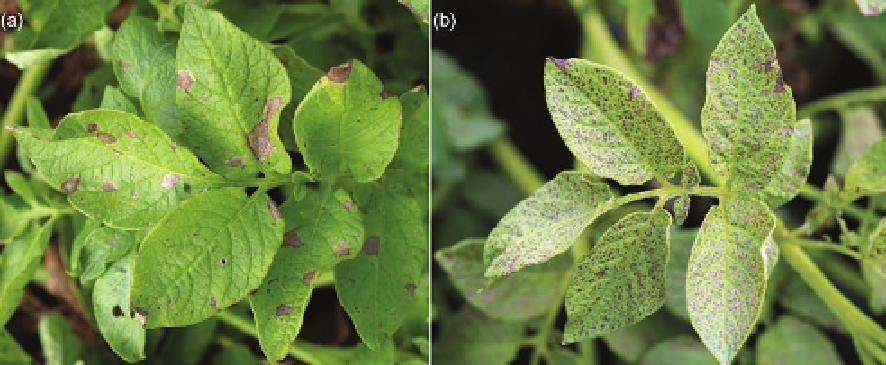Agriculture Reference
In-Depth Information
been produced by the US National Weather Ser-
vice (NWS) since 1994 with the Global Forecast
System (GFS) numerical model (Carrol and Er-
ickson, 2004). Baker and Kirk (2007) developed
a method to derive hourly microclimate vari-
ables associated with potato late blight risk from
the available MOS produced by the NWS. Data
were then fed into a neural network computer
algorithm that generated accurate predictions of
late blight disease risk up to 5 days in the future.
Beginning in 2010, the new Baker and Kirk
(2007) model was incorporated into the Michigan
State University Late Blight Risk Management
website
(http://www.lateblight.org/forecasting.php
).
Intensive, effective fungicide treatment helps
contain losses to less than 5%. Early blight rarely
develops early in the season, and usually appears
on mature foliage. Yield losses can be reduced
with protective, timely fungicide applications
(Pasche
et al
., 2004; Pasche and Gudmestad,
2008; Rosenzweig
et al
., 2008a).
Foliar symptoms of early blight first appear
as small, irregular to circular dark brown spots
on the lower (older) leaves and progress into
characteristic dark, alternating concentric an-
gular rings that are generally restricted by large
veins (Stevenson
et al
., 2007). As Alternaria
brown leaf spot progresses, the lesions coalesce
across large veins and the whole leaf may be-
come chlorotic, with infected areas turning
brown and disintegrating, causing the edges of
the leaf to roll up. The differences between the
blight lesions may range in size from a pinpoint
to 0.3 cm diameter. As the spots enlarge, they
become restricted by leaf veins and take on an
angular shape. Early in the growing season,
early blight lesions on young, fully expanded
succulent leaves may be larger, up to 1.3 cm in
diameter, and may, due to their size, be confused
with late blight lesions. A narrow band of chlor-
otic tissue often surrounds each lesion of both
diseases, and extensive chlorosis of infected foli-
age develops over time. Elongated superficial
brown or black early blight lesions may also form
on stems and petioles. Severe infection of foliage
by the early to mid-bulking period can result in
Early blight and brown leaf spot
Early blight caused by the pathogen,
Alternaria
solani
Sorauer, and brown leaf spot caused by
Alternaria alternata
(Fries.) Keissl are economic-
ally important to potato crops around the world,
as they cause defoliation late in the growing sea-
son and reduce potato yield (Rotem, 1994). Both
are found annually in most potato growing
areas. The timing of their appearance and rate
of disease progress help determine their impact
on the potato crop. The diseases occur over a
wide range of climatic conditions and depend in
large part on the frequency of foliage wetting
from rainfall, fog, dew, or irrigation, on the
nutritional status of foliage, and on cultivar sus-
ceptibility. While losses rarely exceed 20%, if left
uncontrolled these diseases can be very destructive.
Fig. 11.7.
Foliar symptoms of early blight (a) caused by
Alternaria
solani
, and brown leaf spot (b) caused
by
Alternaria alternata
.

